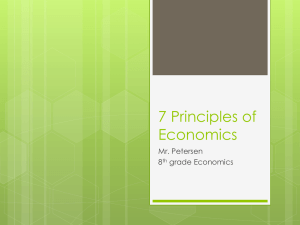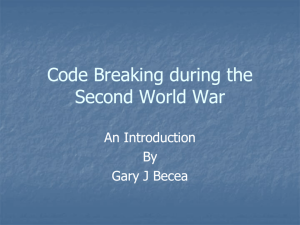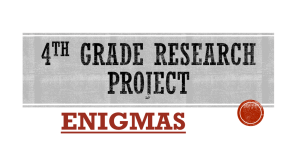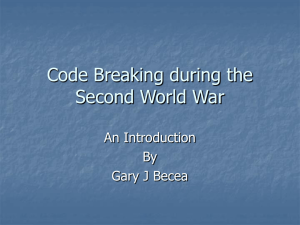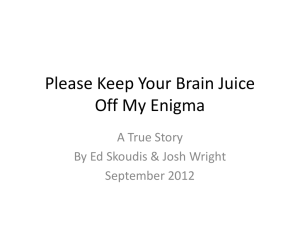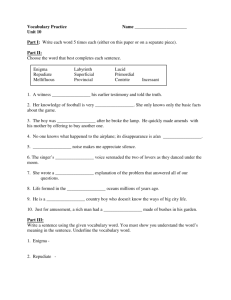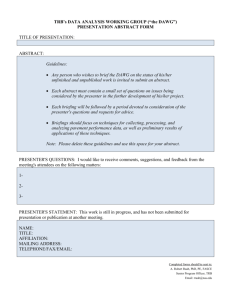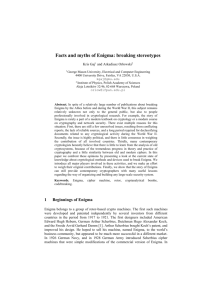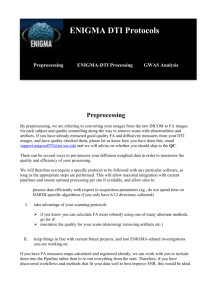doc
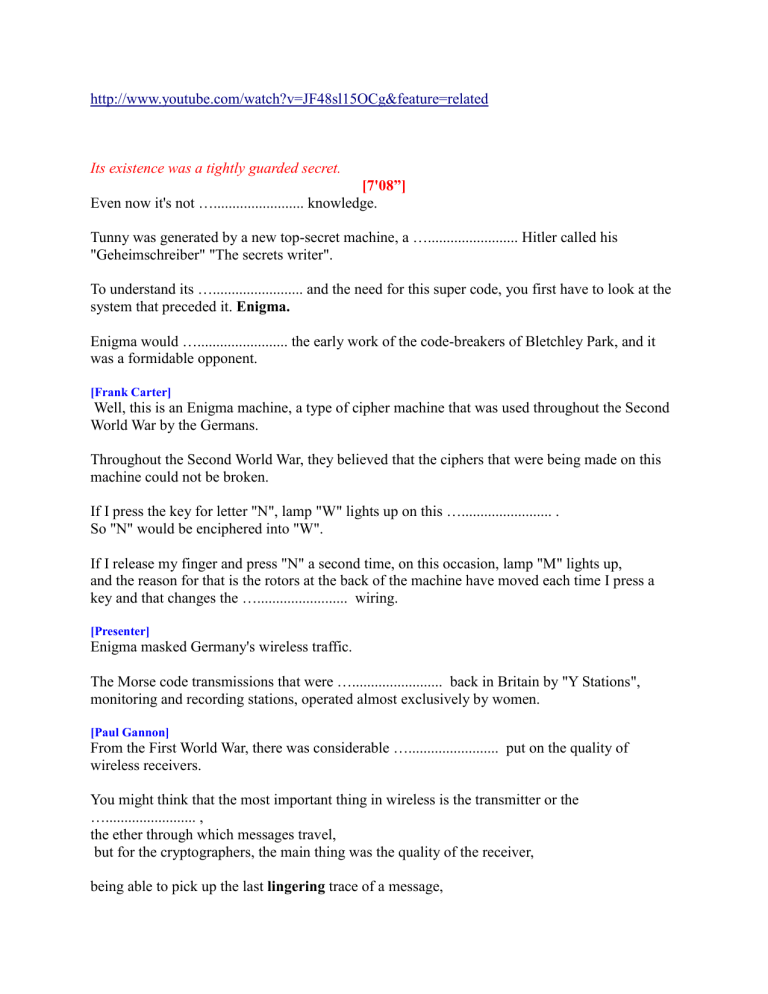
http://www.youtube.com/watch?v=JF48sl15OCg&feature=related
Its existence was a tightly guarded secret.
[7'08”]
Even now it's not …........................ knowledge.
Tunny was generated by a new top-secret machine, a …........................ Hitler called his
"Geheimschreiber" "The secrets writer".
To understand its …........................ and the need for this super code, you first have to look at the system that preceded it. Enigma.
Enigma would …........................ the early work of the code-breakers of Bletchley Park, and it was a formidable opponent.
[Frank Carter]
Well, this is an Enigma machine, a type of cipher machine that was used throughout the Second
World War by the Germans.
Throughout the Second World War, they believed that the ciphers that were being made on this machine could not be broken.
If I press the key for letter "N", lamp "W" lights up on this …........................ .
So "N" would be enciphered into "W".
If I release my finger and press "N" a second time, on this occasion, lamp "M" lights up, and the reason for that is the rotors at the back of the machine have moved each time I press a key and that changes the …........................ wiring.
[Presenter]
Enigma masked Germany's wireless traffic.
The Morse code transmissions that were …........................ back in Britain by "Y Stations", monitoring and recording stations, operated almost exclusively by women.
[Paul Gannon]
From the First World War, there was considerable …........................ put on the quality of wireless receivers.
You might think that the most important thing in wireless is the transmitter or the
…........................ , the ether through which messages travel,
but for the cryptographers, the main thing was the quality of the receiver, being able to pick up the last lingering trace of a message,
and that was where the British radio engineers were considerably more advanced than their
German counterparts,
and the Germans simply didn't …........................ that their messages could be picked up as far away as they were.
They didn't believe that messages from Russia, for example, could be picked up in Britain.
[Presenter]
For the first years of the war those listening posts were …........................ to picking up Enigma traffic.
Then, in 1941, a new and strange …........................ began to be picked out from the ether.
[ [Professor Jack Copeland]
"A new kind of music", it was described as by the British listeners when they first heard it.
[Presenter]
This strange music was a new coding machine delivering messages not by Morse, but by teleprinter.
The information war was about to move into new …........................ .
[The Secret Writer]
The
…........................
of machine-made codes had one immediate effect on Bletchley Park , they began to recruit mathematicians.
[Professor Jack Copeland]
Mathematicians were regarded as sort of…........................ , incomprehensible people and it just wasn't really understood what contribution they could make to code-breaking.
[Paul Gannon]
These machine ciphers that were introduced, Enigma and so on, and there were others as well, are incredibly ........................ mathematically.
I mean, the First World War, the British code-breakers were wordsmiths , people who translated ancient documents for example, cos it was all about words, but in the Second World War it was much more about mathematics.
[Presenter]
The mathematicians were thrown into the front line against this new ........................ system.
Even though the Nazis believed Enigma was ........................ , Hitler demanded more security.
His style of command called for a new and more ........................ communications network.
It would carry more information and supersede the tangle of Morse traffic which his forces generated.
[Professor Jack Copeland]
Enigma was really out of date technology by the time the war started.
Three operators were required and then another three operators at the receiving end.
There'd be the guy who actually typed the message, the operator would have an ........................ who would painstakingly note down the letters as they lit up, and then that would be handed over to a radio operator who would translate that into the "dit-ditda" of Morse code.
And then the process was reversed at the other end. So you had six people co-operating in the transmission of a single message with Enigma. Very slow, very ........................ .
[Paul Gannon]
So the vast volumes of information needed to fight a modern war at that time would simply have overwhelmed a system based upon using an Enigma machine, so they needed something which would ........................ with the throughput of information required.
[Presenter]
And this is it. The machine Hitler had dreamed of. The Lorenz SZ40.
Or as the Allies called it, "Tunny".
[Frank Carter]
This is an example, quite a rare example, of what is called a Lorenz enciphering attachment.
Quite a ........................ machine.
If I lift up the cover and show you the interior.
If you count up, you'll find that this device has got 12 ........................ in it.
The Lorenz was much more sophisticated than Enigma.
The operator at one end typed in plaintext and the operator at the other end received the plaintext on his teleprinter without any ........................ on his part.
[Paul Gannon]
The way in which this Lorenz cipher machine worked was it would apply two layers, two keys, to your message, so it wouldn't encipher it once, it would encipher it ........................ .
The first encipher used five wheels.
Then they would apply a second key and this used similar five wheels and they had another two wheels that were called, what we called stutters in the key.
And then that would generate a ........................ character and this was in order to try and introduce this apparent randomness into the key.
[Presenter]
The 12 wheels made the machine an ........................ generator of code and the number of potential ciphering possibilities multiplied out as:
23 times 26 times 29 times 31 times 37 times 41 times 43 times 47 times 51 times 53 times 59 times 61, which equalled 1.6 million billion combinations.
Another innovation saw the Lorenz incorporate the natural code of the teleprinter into its
........................ design.
[Professor Jack Copeland]
It's kind of modern binary code really.
It's zeroes and ones and they just took the teleprinter code and they encrypted that.
[Frank Carter]
With the Lorenz enciphering device, the plain text letter "A" was changed by a machine which actually added to it a pseudo-random character, for example,
the letter "K" might have been used, for which the teleprinter code was this ,
four crosses and a dot and these two characters were then combined together by a process which is sometimes called "addition".
If the two elements were the same then the result was always a dot.
But if they were different, the answer was a cross.
And here, they're the same so it's a dot.
And if you looked at that set of impulses in terms of the standard international teleprinter code,you would find that that was, in fact, the letter "N".
The letter "A" has been enciphered to "N" by adding this random character "K" to it.
Now, at the receiving station, of course, the letter "N" is the cipher message and we already know that that's going to come in, in terms of this pattern.
And now, a little bit of magic...
If at the receiving station the same random character that was used by the sender was combined with it, in the same way,
Adding up... Two, these are different so the result's a cross.
They're different, the result's a cross.
Same, a dot.
These two are the same, a dot.
And these two are the same, a dot.
The result would be that.
And if we look back, that of course is the old character "A" which was the original plaintext.
[Presenter]
The actual ........................ of teleprinters using this code in the new network was less than 30.
But they were the ........................ of the German command, feeding out to the furthest fingertips of the Third Reich's reach.
More ........................ , as many of the generals needed information about other campaigns as well as their own, one line of traffic could produce an insight into the entire German war
........................ .
This was the prize awaiting the code-breakers.
To get to it, they had to crack a code no-one ........................ , produced by a machine no-one had ........................ , and with a range of possible encryptions that were utterly unimaginable.
16'58''
To defeat the impossible machine, Bletchley would turn to a 24-year-old mathematician called
Bill Tutte.
